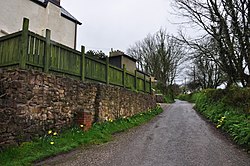Clayhanger, Devon: Difference between revisions
Created page with "{{Infobox town |name=Clayhanger |county=Devon |picture=Clayhanger - Village Lane (geograph 3920335).jpg |picture caption=A lane in the village |os grid ref=ST022230 |latitude=..." |
mNo edit summary |
||
| Line 15: | Line 15: | ||
|constituency=Tiverton and Honiton | |constituency=Tiverton and Honiton | ||
}} | }} | ||
'''Clayhanger''' is a hamlet in the east of [[Devon]], less that a mile west of the [[Somerset]] border | '''Clayhanger''' is a hamlet in the east of [[Devon]], less that a mile west of the [[Somerset]] border. | ||
At the time of the 2011 census the parish had a population of just 127. | At the time of the 2011 census the parish had a population of just 127. | ||
Latest revision as of 14:13, 10 August 2018
| Clayhanger | |
| Devon | |
|---|---|
 A lane in the village | |
| Location | |
| Grid reference: | ST022230 |
| Location: | 50°59’54"N, 3°23’43"W |
| Data | |
| Population: | 127 (2011) |
| Post town: | Tiverton |
| Postcode: | EX16 |
| Local Government | |
| Council: | Mid Devon |
| Parliamentary constituency: |
Tiverton and Honiton |
Clayhanger is a hamlet in the east of Devon, less that a mile west of the Somerset border.
At the time of the 2011 census the parish had a population of just 127.
Roman fort
Clayhanger is close to the site of a Roman fort at Cudmore Farm, overlooking a small tributary of the River Batherm, between the parishes of Clayhanger and Bampton. The site of the fort is a scheduled monument because it is still in a good condition and is considered to be the best surviving example in the West Country. It is rectangular in shape and approximately 100 yards across on each side, with a 25-foot rampart and four outer ditches. Cropmarks inside the site probably show the locations of buildings from the period of the fort. Roman tile and Samian ware have been recovered from the site.[1]
References
- ↑ National Heritage List 1011251: Roman fort NE of Cudmore Farm